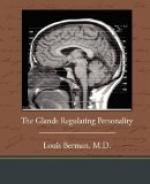From the endocrine standpoint, the reason for this becomes clear. The biometric method concerned itself with externals, with, as it were, symptoms. Since these external signs are but manifestations of the inner chemical reactions, of which the internal secretions are the determining reagents, or factors, with permutations and combinations possible in all directions, the diversity and variability of each individual and his traits stands explained and understandable. The normal, as the perfect or nearly perfect balance of forces in the organism, at any given moment, emerges as a more definite and real concept than that which would abstract it from a curve of variations. Moreover, since the directive forces within the organism are pre-eminently the internal secretions, the normal becomes definable as their harmonious balancing or equilibrium, a state which tends not to undo (as the abnormal does) but to prolong itself.
The potential combinations and compensations, antagonisms and counteractions, attainable within the endocrine glands as an interlocking directorate, point the cause for the elusive quality of the normal. Tall men and short men, blonde women and dumpy women, lanky hatchet-faced people, stout moon-faced people, Falstaff and Queen Elizabeth, George Washington and Abraham Lincoln, Disraeli and Walt Whitman, Caesar and Alexander, as well as Mr. Smith and Miss Jones come within the range of the normal. There are all kinds and conditions and sorts of men and women, and all kinds and sorts and conditions of the normal, because an incalculable number of harmonious relations and interactions between the endocrines are possible, and do actually occur. The standard of the normal must obviously not be a single standard, but a series of standards, depending upon which glands predominate, and how the others adapt themselves to its predominance. Adrenal-centered types, thyroid-centered types, pituitary-centered types, thymus-centered types, as well as hyphenated compounds of these, such as the pituitary-adrenal types, exist as normals. They can be conceived of as normal types because they exist as normal types.
THE SKELETAL TYPES
Now men, for as long as we have any knowledge of their thoughts and classifications and attitudes, have been accustomed to first think of one another, to classify and size one another as tall or short, slender or broad, thin or corpulent. The biological necessity, indeed, instinct of the one animal to relate the other animal to aggressive or harmless agencies in his surroundings, accounts for this. Relatively, of course, for all these modes of description imply offensive or defensive possibilities of the stimulus for the recorder in relation to himself. The interest in stature is fundamental, and has persisted in the most civilized, nations. The relationship of height and weight, as well as of length and breadth, to other physical




